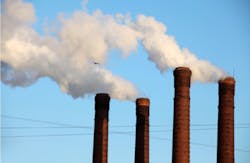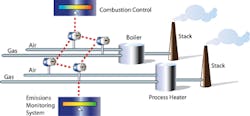Thermal flowmeters are widely used in the process industries for applications including chemical, food & beverage, pharmaceutical, power, pulp & paper, and water & wastewater.
Thermal flowmeters are used in the oil production and exploration, gas production and exploration, and the refining industries. The growth of these industries is all about the need for energy. Higher natural gas and oil prices have made oil and natural gas exploration profitable in many regions where it was not profitable before. The price of a barrel of crude oil is currently in the $90 a barrel range, and the world has a long-term energy need that will get more serious as populations grow and development continues. Even though thermal flowmeters are not widely used in the oil & gas or refining industries, they will still benefit from the increased emphasis on energy production.
In the early 1990s, new environmental regulations began requiring companies to detect and reduce the emission of sulfur dioxide (SO2) and nitrous oxide (NOX) into the air. SO2 and NOX are two principal causes of acid rain. The Environmental Protection Agency (EPA) developed a program involving continuous emissions monitoring. In response to CEM requirements, thermal flowmeter companies developed multipoint thermal flowmeters. Multipoint thermal flowmeters measure gas flow at many points, and use these values to compute flow for the entire pipe, duct, or stack. Some multipoint thermal flowmeters have as many as 16 measuring points.
The election of the Obama administration in 2008 and the Kyoto Accord have resulted in the creation of several mechanisms that measure greenhouse gases. Thermal flowmeters are well suited to making these types of measurements. Examples include recovery of methane from coal mines; biomass gasification; measuring of flue gas, ethanol distillation and refining; measurement and recovery of landfill gas; and measuring and monitoring of flare gas flow. With the reelection of the Obama administration in November 2012, it is likely that the push to measure and curb greenhouse gas emissions will continue. Thermal flowmeters can be expected to continue to have a major role in greenhouse measurement applications.
One area of special interest is measuring and monitoring flare gas, stack gas, and exhaust gas flow. There is a trend for companies to burn off less of this gas, typically in the form of methane, and to use it for other purposes. This is occurring because natural gas is increasingly seen as a cleaner alternative to coal and oil, and as a long-term bridge to renewable energy. In this area of flare gas, stack gas, and exhaust gas flow measurement, thermal flowmeters are actively competing with averaging Pitot tubes and with ultrasonic flowmeters. All three technologies are well qualified for these applications.
Jesse Yoder, Ph.D., is president of Flow Research Inc. in Wakefield, Mass., a company he founded in 1998. He has 25 years of experience as an analyst and writer in process control. Dr. Yoder specializes in flowmeters and other field devices, including pressure and temperature products. Dr. Yoder can be reached at [email protected].
For more research information on thermal flowmeters, visit FlowThermal.com.
Flow Research recently published the latest update of its “Volume X: The World Market for Flowmeters” study, highlighting application and technology trends in flow measurement worldwide. For more details on this study, visit FlowEverything.com.
About the Author
Jesse Yoder
Jesse Yoder, Ph.D., is president of Flow Research Inc. He has 30 years of experience as an analyst and writer in instrumentation. Yoder holds two U.S. patents on a dual-tube meter design and is the author of "The Tao of Measurement," published by ISA. He may be reached at [email protected]. Find more information on the latest study from Flow Research, "The World Market for Gas Flow Measurement, 4th Edition," at www.gasflows.com.

